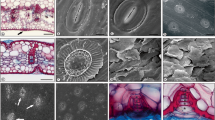Abstract
The leaf architecture has been studied in 19 genera and 35 species of the Brassicaceae. The major venation pattern is pinnate craspedodromous with the exception ofAlyssum maritimum, Iberis amara, I. umbellata andMalcolmia maritima where it is pinnate-festooned brochidodromous. The number of secondary veins and their angle of divergence vary from species to species and even within the same species. Marginal ultimate venation is mostly looped occasionally incomplete. The areole size and shape is variable. The veinlets may be simple or once or twice dichotomously divided. The simple veinlets may be curved or hooked. The tracheids are either uni-, bi-, tri- or multiseriate and extraordinarily variable in size and shape. Isolated vein endings, isolated free vein endings, isolated tracheids and extension cells are observed. Myrosin cells have been observed inEruca vesicaria ssp.sativa andCochlearia cochlearioides.
Similar content being viewed by others
References
Dilcher, D.L. 1974. Approaches to the identification of angiosperms leaf remains. Bot. Rev.40: 1–157.
Ettingshausen, C.R. Von. 1861. Die Blattskelette der Dicotyledon. Vienna.
Foster, A.S. 1950a. Morphology and venation of the leaf inQuiina acutangula Ducke. Amer. J. Bot.37: 159–171.
— 1950b. Venation and histology of leaflets inTouroulia guianensis Abul andForesia tricarpapires. Amer. J. Bot.37: 848–862.
— 1956. Plant idioblasts: Remarkable examples of cell specialization. Protoplasma46: 184–193.
— 1961. The phylogenetic significance of dichotomous venation in angiosperms. Res. Adv. Bot.2: 971–975.
Gupta, B. 1961. Correlation of tissues in leaves. I. Absolute vein-islet numbers and absolute veinlet termination numbers. Ann. Bot.25: 65–70.
Hall, J.P. andC. Melville. 1951. Veinlet termination numbers: a new character for the differentiation of leaves. J. Pharm. Pharmacol.3: 943–946.
—. 1954. Veinlet termination number: Some further observations. J. Pharm Pharmacol.6: 129–133.
Hara, N. 1962. Histogenesis of foliar venation ofDaphne pseudomezereum A. Gray. Bot. Mag. Tokyo75: 107–113.
Heinricher, E. 1886. Die Eiweisslauche der Cruciferen und verwandte Elemente in der Rhoeadinenreihe. Mitt. Bot. Inst. Graz.1, 1–92.
Hickey, L.J. 1973. Classification of architecture of dicotyledonous leaves. Amer. J. Bot.60: 17–33.
Kasapligil, B. 1951. Morphological and ontogenetic studies ofUmbellularia californica Nutt. andLaurus noblis L. Univ. Calif. Publ. Bot.25: 115–240.
Kerner, A.J. andF. Oliver. 1897. The Natural History of Plants. Blakie and Son, London.
Levin, F.A. 1929. The taxonomic value of veinlets areas based upon a study of the generaBarasma, Cassia, Erythroxylon andDigitalis. J. Pharm. Pharmacol.2: 17–43.
Melville, R. 1976. The terminology of leaf architecture. Taxon25: 549–561.
Moutan, J.A. 1970. Archetecture de la aervation foliare. Compt. Rend 92 Congr. Nat. Sci. Sav.3: 165–196.
Nicely, K.A. 1965. A monographic study of the Calycanthaceae. Castancea30: 38–81.
Plymale, E.L. andR.B. Wylie. 1944. The major veins of mesomorphic leaves. Amer. J. Bot.31: 99–105
Pray, T.R. 1954. Foliar venation of angiosperms. I. Mature venation ofLiriodendron. Amer. J. Bot.41: 663–670.
Radford, A.E., W.C. Dickison, J.R. Massey andC.R. Bell. 1974. Vascular Plant Systematics. Harper & Row Publ., New York.
Rao, V.S., K.N. Shenoy andJ.A. Inamdar. 1980. Technique for clearing the leaves. Microscopica Acta83: 307–311.
Seghal, L. andG.S. Paliwal. 1974. Studies on the leaf anatomyEuphorbia II. Venation pattern. Bot. J. Linn. Soc.68: 173–208.
Strain, R.W. 1933. A study of vein endings in leaves. Ann. Midland Naturalist14: 367–375.
Verghese, T.M. 1969. A contribution on the foliar venation of Scrophulariaceae.In: K.A. Chowdary, ed., Recent Advances in the Anatomy of Tropical Seed Plants. p. 253–265. Hindhustan Publ., New Delhi.
Author information
Authors and Affiliations
Rights and permissions
About this article
Cite this article
Rao, N.V., Inamdar, J.A. Leaf architectural studies in the brassicaceae. Bot Mag Tokyo 96, 15–28 (1983). https://doi.org/10.1007/BF02489571
Received:
Issue Date:
DOI: https://doi.org/10.1007/BF02489571




